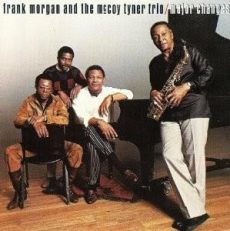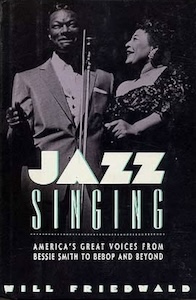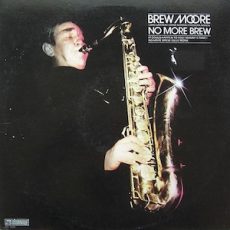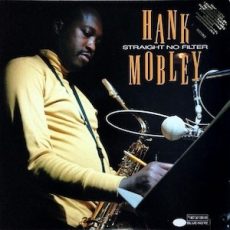
Requisites
Major Changes ~ Frank Morgan and The McCoy Tyner Trio | By Eddie Carter 6.15.25
During the five years I lived in Cincinnati, Ohio, Everybody’s Records was a favorite shop I regularly visited. It was there that I heard Major Changes (Contemporary Records C-14039) by Frank Morgan and the McCoy Tyner Trio spinning on the turntable. As I listened, memories of when I first became a jazz fan came rushing back, and I picked it up immediately. Frank was born in Minneapolis, Minnesota, and began playing the guitar at a young age. His father introduced him to Charlie Parker, who inspired him to play the clarinet at age seven. Morgan later graduated to the soprano sax, then the alto sax, which became his primary instrument. Rounding out the ensemble are McCoy Tyner on piano, Avery Sharpe on bass, and Louis Hayes on drums. My copy of the album is the 1988 U.S. stereo release.
The quartet kicks off the first side with Changes by McCoy Tyner. The pianist’s brisk introduction sets the tone for their feisty melody. McCoy takes the first bite of this jazzy apple with a high-spirited solo. Frank follows with a vigorous statement, then Avery’s vivacious interpretation guides the group back to the theme’s reprise and fadeout. Irving Berlin’s How Deep Is The Ocean starts on a deceptively slow note, with the alto sax and piano sharing a private conversation ahead of the foursome’s sprightly theme. Tyner leads the charge with a swinging opening statement. Morgan builds on this momentum with a feisty reading. Sharpe rounds out the solos with a brief presentation leading to the out-chorus and exit.
Emily is a lovely composition by Johnny Mandel and Johnny Mercer. Frank begins delicately expressing each note of the melody with heartfelt sensitivity. McCoy’s opening solo is delivered with tenderness and warmth. Frank concludes with a gentle presentation, leading to a serene and graceful finish. Search For Peace by McCoy Tyner begins with Hayes’s introduction, leading into the quartet’s theme, which moves at a bright and brisk clip. The pianist starts the opening solo with remarkable precision and vibrant enthusiasm. Sharpe and Hayes share a brief interlude, then Morgan effortlessly glides over the rhythm section, perfectly attuned to Hayes’s flawless timing, until the closing chorus fades into nothingness.
McCoy Tyner announces Frank’s Back with a smooth lead-in, segueing into the opening ensemble at medium-tempo to begin the second side. Frank sets a stellar example for the group in the first solo. McCoy follows with a charismatic interpretation, then Frank and Louis share an exchange of notes, leading back to the reprise and conclusion. Oscar Hammerstein II and Jerome Kern’s All The Things You Are opens with the saxophonist’s soothing introduction ahead of the group’s mellow theme. Morgan’s opening statement starts strong and doesn’t let go until Tyner takes his turn. The pianist launches into a taut second reading that holds the listener’s attention until Morgan returns briefly, leading to the theme’s reprise and a graceful exit.
Theme From Love Story by Francis Lai and Carl Sigman comes from the 1970 romantic drama. The rhythm section’s introduction is simultaneously delicate and inviting, leading Frank to explore the intricately beautiful melody. McCoy captures the song’s essence with lively exuberance in the opening statement. Frank then weaves a tapestryof grace and elegance before the theme resurfaces, and the quartet fades into a poignant stillness. Richard Bock produced Major Changes. Ed Rak was the engineer behind the direct-to-digital recording, and George Horn mastered this release. The album boasts a superb soundstage that envelops the listener’s sweet spot, as if they’re seated in the studio alongside the musicians.
Frank Morgan battled heroin addiction for much of his life, mirroring the path of Charlie Parker. This struggle led him to spend a significant portion of his adult years in and out of prison. However, by the mid-1980s, he managed to overcome his dependency, remaining clean for the final two decades of his life, though he continued taking methadone daily. Morgan recorded twenty-one albums as a leader and contributed to twelve more as a sideman. Despite suffering a stroke in 1998, he made a remarkable recovery and continued to perform and record music during the last nine years of his life. Toward the end of his career, Morgan successfully completed his first European tour. He passed away from complications of colorectal cancer on December 14, 2007, just nine days before his seventy-fourth birthday.
The album’s title reflects the significant shifts in Morgan’s life and music, while highlighting the extraordinary chemistry between the musicians. Whether you're a seasoned jazz aficionado or a newcomer to Morgan’s music, Major Changes by Frank Morgan and the McCoy Tyner Trio is a treasure trove of captivating tracks and stunning solos. It also serves as a delightful showcase of his talent, and I wholeheartedly recommend checking it outthe next time you’re out record-shopping!
~ All The Things You Are – Source: JazzStandards.com
~ Theme From “Love Story” – Source: Wikipedia.org
© 2025 by Edward Thomas Carter
More Posts: choice,classic,collectible,collector,history,instrumental,jazz,music,piano,saxophone

On The Bookshelf
JAZZ SINGING | WILL FRIEDWALD
America’s Great Voices From Bessie Smith To Bebop and Beyond
Jazz Singing is a biographical guide for those who desire to be knowledgeable about those voices that made the 20th century a great time in the creation of music. This treatise of 832 pages covers 210 singers from Ella Fitzgerald, Sarah Vaughan, Louis Armstrong and Frank Sinatra to Elvis Presley, Johnny Mathis and Patti Page, to lesser known Jackie Paris, David Allyn, Edythe Wright, Irene Reid and everyone in between.
This book is not meant to be read from covers to cover. One should take a sip, uncovering nugget by nugget of information and insight on the classic blues stylists of the 1920s who laid the foundation on which the two greatest singers in our history, Louis Armstrong and Bing Crosby, built a tradition.
Jazz Singing reveals how the master jazz and pop singers created, what made them great, and why their music has the power to touch us so profoundly.

Daily Dose Of Jazz…
John Troy was born on June 3, 1989 in Buffalo, New York. He began playing the saxophone at age twelve. After showing exceptional ability in the classical realm throughout middle school, with the tutelage of William Eicher, his attention gradually turned toward the study of Jazz Saxophone. He honed his skills with lead alto saxophone for Concert and Jazz All-County Ensembles, and New York All-State Bands as well.
John played both lead alto and tenor in the Fredonia Jazz Ensemble, student big band. He can be heard on the 2009 release of the FJE’s, Still Kickin’ and his debut album All Ahead Flank. He led his own small groups, Jazz Quintessential, and an organ trio, the JT Trio both with significant success.
He has performed and/or studied with the likes of Eric Alexander, Grant Stewart, Ralph Lalama, Todd Coolman, Tim Armacost, Chris Potter, Tom Harrell, Stacy Dillard, Hal Galper, Arturo O’ Farrell, and Pete Malinverni, among others.
Tenor saxophonist John Troy continues to find his musical way through performance and recording in the hard bop genre..
More Posts: bandleader,history,instrumental,jazz,music,saxophone

Requisites
No More Brew ~ Brew Moore | By Eddie Carter
This morning’s album offered for your consideration is a live performance by Brew Moore. No More Brew (StoryvilleSLP-4019) was his final album, released eight years after his passing. Brew was born in Indianola, Mississippi and began playing the trombone at age twelve, later graduating to the clarinet and eventually the tenor saxophone. His professional journey took him from a Texas territorial band before attending college, to New Orleans, Memphis, and New York, to further his craft. He’s joined on stage by Lars Sjösten on piano, Sture Nordin on bass, and Fredrik Noren on drums. My copy is the 1981 U.S. Stereo release.
The set begins with Jimmy Van Heusen and Johnny Burke’s It Could Happen To You. Lars opens with a swinging introduction, setting up the quartet’s theme. Brew launches into a sizzling solo. Lars comes in energetically next. Sture illustrates he’s an effective soloist in a polished reading. Brew and Frednik exchange a brief dialogue, leading to the theme’s return and closure. Moore addresses the audience, then Sjösten’s introduction leads into the ensemble’s lively melody of Manny’s Tune by John Marabuto. Moore takes off first quickly. Sjösten responds with an impressive reading. Moore and Noren wrap things up with a concise conversation ahead of the closing chorus and abrupt finish.
Brew’s contribution to the set, No More Brew begins Side Two with the foursome’s joyful introduction and melody. Moore opens with energetically captivating phrases, then Lars’s vigorous reading flows through the rhythm section like ephemeral shadows. Brew and Fredrik fuel the finale with a concise comment preceding the theme’s return and a short announcement by Moore that concludes with Blue Monk by Thelonious Monk. The quartet begins with a soulful, blues-inspired melody that sets the stage for Moore to accelerate into an extended, captivating solo. Sjösten mines a rich vein of sentimentality next until the tempo slows again for the melody’s reprise and exit.
Rune Öfwerman produced the album, although it’s unknown who recorded it. However, the album’s sound quality is excellent, with a soundstage placing the listener in the club audience as the musicians are performing. Brew Moore, known for his irresistibly appealing tone that could either stir excitement or touch the heart, recorded twelve albums as a band leader and contributed to seven more as a sideman. Tragically, he passed away on August 19, 1973, at age forty-nine after a fatal fall down a flight of stairs. If you’re a fan of swing and bop and also enjoy the tenor sax, I highly recommend exploring No More Brew by Brew Moore on your next record store visit. This exceptional album showcases a talented young musician whose promising career was sadly cut short!
~ Blue Monk – Source: JazzStandards.com
~ It Could Happen To You – Source: Wikipedia.org
© 2025 by Edward Thomas Carter
More Posts: choice,classic,collectible,collector,history,instrumental,jazz,music,saxophone

Requisites
Straight No Filter ~ Hank Mobley | By Eddie Carter 5.4.25
This morning’s album from the library is one of my favorites by tenor man Hank Mobley. Straight No Filter (BlueNote BST 84435) is a 1986 release of previously unreleased tracks culled from three sessions in 1963, 1965, and 1966. Hank composed all the tracks on this album. He’s joined by Donald Byrd (track: B3), Freddie Hubbard (B1,B2), and Lee Morgan (A1 to A3) on trumpet, Herbie Hancock (B3), Barry Harris (B1, B2), and McCoy Tyner (A1 to A3), Paul Chambers (B1, B2), Bob Cranshaw (A1 to A3), and Butch Warren (B3) on bass, Billy Higgins (A1 to B2), and Philly Joe Jones (B3) on drums. My copy is the U.S. Direct Metal Mastering stereo release.
The title track, Straight No Filter, kicks off the album with the rhythm section’s lively introduction to the ensemble’s melody. Hank launches into the opening statement. Lee maintains the spirited groove in the following solo, and then McCoy takes the energy to a new level. Hank and Lee exchange a few choruses, leading back to the theme and climax. Chain Reaction starts swiftly from the trio’s introduction into the front line’s uptempo theme. Tyner leads the way with an infectiously energetic solo. Morgan swings into the second solo with considerable zest and a bright tone, then Mobley soars briskly through the finale into the theme’s restatement and a slow fade.
Soft Impressions opens with the rhythm section setting a soothing mood for the quintet’s theme. Hank establishes a smooth and easy groove in the opening statement. Lee adds to the relaxing atmosphere in the second interpretation, and then McCoy’s closing solo is as refreshing as an oasis in the desert until the theme’s reprise and climax. Third Time Around begins the second side with Chambers’s introduction ahead of the group’s medium melody. Mobley gets right down to business in the lead solo, then Hubbard provides a beautifully executed statement. Harris provides a pleasantly relaxing reading next, and Chambers walks with a bluesy bounce before the closing ensemble exits.
Hank’s Waltz is a catchy blues that Barry introduces ahead of the ensemble’s entrance. Hank breaks the ice with an infectious swing, then Lee adds a spicy touch in the second solo. Barry further elevates the mood in the final statement, before the theme is revisited and the rhythm section gently fades out. The group serves up a delicious plate of Syrup and Biscuits for the album’s finale. After the engaging theme is established, Mobley fires up the joyful energy in the opening solo. Byrd maintains a cheerful vibe in the following performance. Both horns engage in a vibrant exchange preceding the closing chorus.
Alfred Lion produced the original sessions, and Michael Cuscuna produced this release. Rudy Van Gelder was behind the dials on each date. The album boasts an excellent soundstage, transporting the musicians to the sweet spot in your listening room. Mobley was one of the best tenor men in jazz, with an outstanding discography as both leader and sideman. If you enjoy hard bop, consider adding Straight No Filter by Hank Mobley to your list on your next vinyl hunt. It’s a delightful surprise featuring some excellent playing by Hank and his bandmates across three stellar sessions, making it a highly recommended addition to any jazz library!
© 2025 by Edward Thomas Carter
More Posts: choice,classic,collectible,collector,history,instrumental,jazz,music,saxophone



